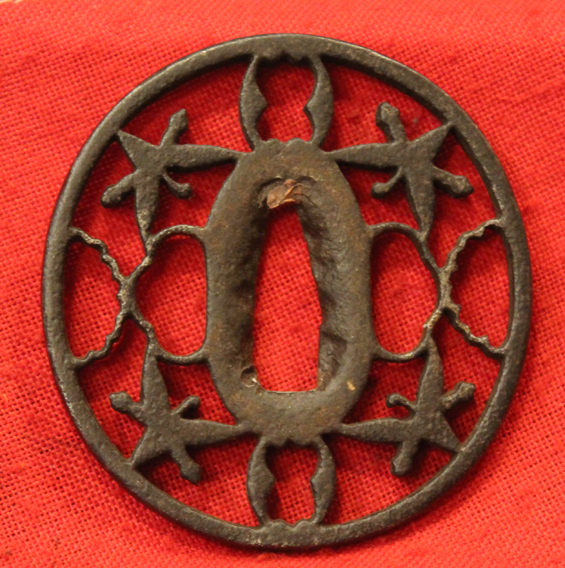A Good Koto Period O Sukashi Tsuba
Cirtca 1550. Probably Owari school. The OWARI school should be divided into three periods. The first period comprises those pieces made in the Muromachi age. The earliest tsuba of the first period are a little younger than the earliest Kanayama tsuba. The second period is the work of the Momoyama age. The third period is from the early Edo age to the Genroku era (1688-1703). A few facts may be stated based on examination of the work of this school. They are always of positive silhouette design. The subjects of the designs vary greatly but they always have in common a strong masculine feeling. They are a noble tsuba whose influence may be seen in many contemporary schools.
Yamasaka Kichibei was the name of the first tsuba artist of this family. Later members of this school shortened the name to Yamakichibei, still later onwe see the name Yamakichi. The working period of the first Yamasaka Kichibei is from Tensho to Keicho eras (1575-1615), about contemporary with the second Nobuiye. The first generations lived in the Kiyosu area, but the later generations lived at Nagoya in Owari Province. Tsuba were made by whole dynasties of craftsmen whose only craft was making tsuba. They were usually lavishly decorated. In addition to being collectors items, they were often used as heirlooms, passed from one generation to the next. Japanese families with samurai roots sometimes have their family crest (mon) crafted onto a tsuba. Tsuba can be found in a variety of metals and alloys, including iron, steel, brass, copper and shakudo. In a duel, two participants may lock their katana together at the point of the tsuba and push, trying to gain a better position from which to strike the other down. This is known as tsubazeriai pushing tsuba against each other.
Code: 20801
495.00 GBP

